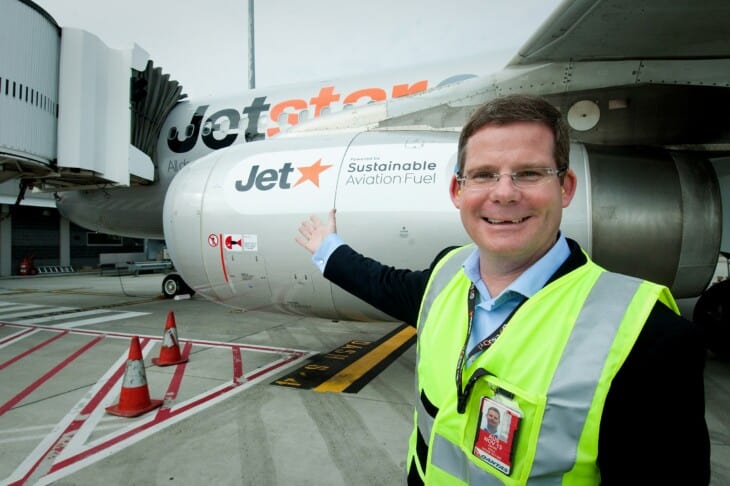Recent years have seen the aviation industry push to reduce its emissions, which currently make up 2% of the world’s entire carbon emissions. The introduction of sustainable aviation fuel is just one of the ways that airlines and other aircraft operators are trying to reduce their carbon footprint.
Despite being more environmentally friendly than its traditional counterparts, sustainable aviation fuel has been both praised and criticized by industry professionals and environmental activists alike. But what exactly is it, and what is all the fuss about?
Sustainable aviation fuel (SAF) is a term applied to any renewable fuel that is a direct substitute for traditional fossil fuel-based aircraft fuels. They have similar molecular properties to traditional aviation fuels but considerably lower carbon emissions, making them perfect for an industry looking to become greener on the whole.
What is Sustainable Aviation Fuel?
Sustainable aviation fuel (SAF), otherwise known as biojet fuel or renewable jet fuel, is a type of aircraft fuel that is designed to be a greener alternative to traditional crude oil-based jet fuels.
SAFs are made from resources, known as feedstocks, ranging from agricultural waste, to alcohol, to animal fat, which all come from renewable sources (as opposed to the non-renewable sources of crude oil used to make traditional jet fuel).
When combusted in the aircraft’s engine, SAF emits less carbon dioxide than traditional jet fuel whilst also further offsetting their emissions thanks to the carbon dioxide absorbed during the growth/production of their feedstock.
This allows airlines and other aircraft operators to reduce their carbon emissions and mitigate the environmental impact of their flights without having to sacrifice customer satisfaction or reduce the number of flights they operate.

As SAF is refined to be a hydrocarbon with the same chemical structure as traditional jet fuel, its adoption allows airlines to use pre-existing infrastructure and technologies to adopt this fuel type quicker, allowing airlines and other aircraft operators to reduce their carbon emissions at a much faster pace than they would be otherwise.
Although the first modern sustainable aviation fuel came about back in the early 2000s, it only began to gain traction in the mid-to-late 2010s, with it becoming more and more popular with each passing year.
What Are The Types of SAF?
Although Sustainable Aviation Fuels are still only relatively new, there are four main types of SAF, categorized based on how they are produced. They are:
Hydroprocessed Esters And Fatty Acids (HEFA)
Hydroprocessed Esters and Fatty Acids (HEFA) is the main type of SAF that is derived from lipid (fat)-based feedstocks like plant oils, used cooking oil, and/or animal fat.
To turn these feedstocks into SAF, they undergo a chemical process called hydroprocessing; mixing the feedstock with hydrogen gas in a reactor with the help of catalysts. This process turns lipids into hydrocarbons that chemically resemble traditional jet fuel.
Fischer-Tropsch (FT)
FT SAF uses biomass, coal or natural gas as a feedstock. It generally undergoes a gasification process (if biomass or coal) where it is exposed to high temperatures (as much as 1,200°C/2,192°F) and reacts with limited amounts of oxygen.
This turns it into a synthetic gas made from hydrogen and carbon monoxide. This synthetic gas is then exposed to even higher temperatures and is reacted with catalysts to reform the hydrogen and carbon monoxide into liquid hydrocarbons.
Alcohol-to-Jet (ATJ)
By far the most common type of sustainable aviation fuel, alcohol-to-jet is the type of SAF derived from alcohol, commonly in the form of ethanol or butanol.
ATJ is made by first dehydrating (removing the water molecules) from the alcohol feedstock. It is then oligomerized (reacted together to form hydrocarbon chains) before being reacted with hydrogen gas to form longer hydrocarbon chains.
Catalytic Hydrothermolysis (CH)
A still somewhat experimental type of SAF, catalytic hydrothermolysis converts biomass feedstock into usable SAF by reacting it in highly pressurized environments whilst being exposed to incredibly high temperatures and water.
Though there have been numerous successful attempts at producing CH SAF to date, it likely still requires a few more years of research before it starts being used as an alternative to traditional jet fuel.
What’s The Difference Between Blended And Unblended Sustainable Aviation Fuel?
When looking at the different types of SAF, you may also find them categorized into “blended” and “unblended”. These terms refer to the composition of the SAF in question.
Blended SAF is a mixture of traditional jet fuel and sustainable aviation fuel. As SAF and jet fuel are interchangeable (unlike gasoline and diesel in car engines), the blend can be favored in one direction or the other; it doesn’t (and usually isn’t) a 50-50 blend.
For example, some of the most popular blended SAFs are a 70-30 blend, meaning that 70% of the fuel is made from SAF, whilst the remaining 30% is from traditional jet fuel. This allows operators to reduce their emissions whilst staying within existing fuel infrastructure.
Unblended SAF, on the other hand, is what you might call “pure” SAF. It doesn’t have any traditional aviation fuel in it – instead solely being HEFA, FT, ATJ or CH (depending on the particular fuel) – and has net zero, or sometimes even negative, carbon emissions.
Is Sustainable Aviation Fuel Cheaper Than Jet Fuel?
As of writing this article in mid-2023, the national average price of Jet A fuel is approximately $6.30 per gallon according to GlobalAir. By contrast, SAF has a national average price of $8.52, meaning jet fuel is significantly cheaper than sustainable aviation fuel.
This follows a long trend of traditional jet fuel being considerably cheaper than SAF, which is one of the main reasons some airlines have been hesitant to commit to using SAF; their fuel bills are already high enough without deliberately raising them.
To encourage more airlines to use SAF, and thus lower its price by encouraging more efficient (and total) production to lower costs, some analysts have suggested placing a tax on traditional aviation fuel and/or subsidizing SAF.
And while no country has yet done either, it is highly likely that once SAF becomes more prevalent, it will become cheaper than Jet A and other types of aviation fuel.
Does SAF Produce CO2?
Yes, Sustainable Aviation Fuel does produce some carbon dioxide (CO2) when burned, much like traditional jet fuel does. That being said, when compared to traditional jet fuel, SAF produces 80% less CO2, meaning it’s far more environmentally friendly.
Unlike traditional jet fuel, whose CO2 production almost completely occurs when burned, SAF CO2 production occurs in two stages.
The first occurs when the base products (either biomass or waste materials) are turned into SAF. As this is a heavily industrial process, carbon dioxide is released into the atmosphere, just as during the production of fossil fuels, though to a lesser degree.
The second occurs during combustion. When burned in aircraft engines, SAF releases CO2 into the atmosphere much like the combustion of jet fuel does, though again, to a lesser extent.
Whilst SAF produces less CO2 overall, it is further offset by the production of the base products, particularly with biomass, which takes CO2 out of the atmosphere through photosynthesis, thus reducing SAF’s carbon footprint.
Is SAF Really Green?
Despite being greener than traditional jet fuel, SAF has been routinely criticized as little more than a PR attempt by airlines to appear like they care about the environment whilst doing very little to reduce their huge carbon footprints.
Whilst SAF is by no means carbon-free, it is far better for the environment than what has been used by airlines thus far.
With aviation producing an estimated one billion tons of CO2 annually, an 80% reduction based just on changing fuel sources is huge. And that’s without taking into account the adoption of newer, more fuel efficient aircraft!
If you are still unconvinced, there is a strong argument to be made that SAF is just the placeholder until electric aircraft technology advances to the point where it replaces conventional combustion engine-powered aircraft used today.
Sort of like how hybrid engines are being used in cars while electric car battery and charging technology and associated infrastructure advance to the point where they can replace almost all combustion engine cars.
Who Produces Sustainable Aviation Fuel?
The original sustain aviation fuels were produced in labs by scientists and researchers testing alternative ways to fuel aircraft. Today, production of SAF is performed on an industrial scale, largely by for-profit manufacturers.

Most sustainable aviation fuel producers are newcomers, such as LanzaJet, Gevo and Velocys, each specializing in the production of a particular type of SAF (eg. Velocys pedicure Fischer-Tropsch SAF, whilst LanzaJet produces Alcohol-to-Jet SAF).
However, several oil companies, most notably BP and Shell, have entered the SAF market in an attempt to stay relevant in a world rapidly shifting away from oil as well as maintain their market share in the aviation fuel market.
Whilst each currently sell their own brands of SAF, both companies have agreements and partnerships with dedicated SAF producers, combining the financial strength and production capabilities of these oil giants with the niche expertise these newer players bring.
As of 2023, the largest SAF producers are:
- Neste: Based in Finland, SAF production is 1.5 million tons per year
- Alder Fuels: Based in the UK, SAF production capacity is 34 million gallons per year
- World Energy: Based in the US, SAF production capacity is 45 million gallons per year
- SkyNRG: Based in the Netherlands, SAF production capacity is 100,000 tonnes per year
Rather surprisingly, the country that produces the most SAF is not Finland, the UK, the US or the Netherlands, but rather Singapore, who produce over a million tonnes of SAF, almost entirely from the Neste plant opened in the country in mid 2023.
Which Airlines Use SAF?
When sustainable aviation fuel first emerged, airlines were hesitant to adopt it. Slowly but surely, almost all of the world’s major airlines have begun to incorporate SAF into their operations.
Whilst a lack of supply has meant that no airline currently uses entirely or majority SAF to power their flights, several major airlines have made significant progress in their use of SAF:
- Alaska Airlines became the first major US airline to use SAF to power select flights back in 2016
- Delta Airlines have been using SAF to power all of their long-distance flights originating in the United States
- Qantas has begun making steps to produce their own SAF and is currently in the process of building a dedicated facility in Queensland, Australia
In addition to this, several airlines have partnered with many of the above SAF producers to boost those companies’ SAF production and reach their own targets of becoming carbon neutral.
Some airlines, however, have taken their partnerships one step further: in 2015, United Airlines made a $30 million investment in SAF producer Fulcrum BioEnergy, making the airline an owner in the company as well as its industrial partner.
Although most major airlines have begun to use SAF on at least some of their flights, smaller carriers (particularly charter and low-cost airlines) and those located in growing aviation markets in Asia, Africa and South America have been hesitant to adopt SAF.
Can Private Jets Use SAF?
Whilst most of the mainstream media has focused on the adoption of SAF by airlines, there has been an equally intense drive by most commercial private jet operators to adopt SAF on at least some of their flights.
For the most part, this has been for the same reason airlines have done it: to reduce their carbon footprint and placate those critics of private jet travel who believe it should be banned because of its carbon emissions.
However, much like with airlines, the lack of supply limits how many private jets can use sustainable aviation fuel on their flights. That being said, when private jets do use SAF, they continue to set new records for speed and distance.
At present, the longest flight performed by any aircraft powered by sustainable aviation fuel was a private jet. On October 23rd 2021, a Gulfstream G700 took off from Houston, Texas and landed in Riyadh, Saudi Arabia 13 hours and 40 minutes later. The flight was fueled by blended SAF.
Is There SAF For General Aviation Aircraft?
Whilst there has been a huge push for the introduction of SAF in the commercial aviation industry, sustainable aviation fuel has been used in General Aviation since the early 2000s.
Though it is still not widespread by any means, many of the largest General Aviation (GA) airfields in the country currently offer pilots the option of traditional AvGas and SAF.
Globally-speaking, the adoption of SAF in the GA market is limited mostly to North America and Europe. Growing GA markets in Asia, Africa and South America have yet to begin using SAF in any real capacity.
Related Posts













